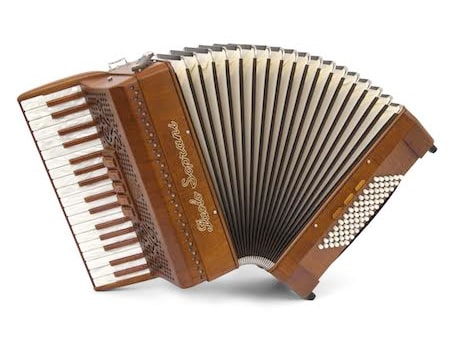An accordian is a popular musical instrument in many cultures around the world and widely played across its variety of scales and chords.
Accordions can either be unisonoric (playing the same note regardless of direction) or bisonoric (two distinct notes depending on which way the bellows are moving). Some types also feature bass buttons for accompaniment purposes.
Chinese cheng
The Chinese Cheng (Chinese: Sheng; pinyin: Di Yin Sheng) is a multiphonic free reed wind instrument. Composed of seventeen vertical pipes of bamboo or metal connected by hinges and connected to a mouthpiece, its notes can be generated either through inhalation or exhalation of air, similar to the concertina.
The cheng is an instrument used in folk music, dance and martial arts – its versatility and musicality having earned it a prominent place within Chinese musical tradition.
The Cheng is commonly known as the “phoenix accordion”, due to its resemblance to a phoenix’s double wings which symbolize strength and power. It was believed to have been one of the first Chinese musical instruments imported into Europe, where its influence led Europeans to create modern accordions.
German accordion
Accordions are an iconic musical instrument with wide-ranging applications across several genres worldwide. First created in Europe but only coming into their current form later that century, acordian are becoming widely recognized and have become widely adopted across a variety of styles of music.
Cyrillus Damian, a Viennese instrument maker, first patented an instrument commonly known as an accordion in 1829. His invention featured two to four bass keys which produced chords within an octave range.
Basque accordion
The Basque accordian is one of the primary instruments used in traditional Basque music and dance, most frequently seen accompanying txistu, alboka and other traditional instruments at weddings and other community events in both Basque regions as well as in emigrant communities.
There are various kinds of accordions, each with its own set of unique characteristics. Most are bisonoric accordions – meaning each button produces two notes when compressed or expanded by the bellows – as this helps maintain continuity when playing two distinct chords on different buttons simultaneously.
There are also diatonic accordions which produce unisonoric notes when expanded or compressed; one such instrument is the Schwyzerorgeli, with 31 treble buttons arranged over three rows and 9 bass buttons over two bass rows.
Russian bayan
An accordian is a musical reed instrument used for producing beautiful melodies. Additionally, it’s commonly referred to as harmonica or mandolin.
The bayan is an accordian used in Russian music. First developed during the early 20th century, this musical instrument has since become widely popular throughout Russia.
The bayan is an ancient and unique form of button accordion with its own distinctive sound and tone, set apart from western accordions by producing fuller bass tones.
Schrammelquartet
The Schrammelquartet is a traditional Viennese ensemble composed of two violins or fiddles, a double-necked contraguitar, and a G clarinet (or picksusses Holzl). Performers strive for an emotive yet melodious sound through this performance art piece.
Johann and Josef Schrammel founded their musical group in 1878. These two brothers were the illegitimate sons of Vienna clarinettist Kaspar Schrammel, who taught them both music performance and composition skills.
Their musical ensemble quickly found an enthusiastic following, performing at various taverns and wine gardens throughout Vienna; becoming known as ‘Nussdorfers’ after their favorite pub in Nussdorf suburb.
In 1884, the trio expanded into a quartet with clarinetist Georg Danzer joining. Soon thereafter, their fame quickly spread, as the group performed across Europe and even took part in the 1893 Chicago World’s Fair. Together, they composed over 200 songs and music pieces during their seven year existence, earning themselves a reputation for combining old Vienna charm and sophistication with humor and tradition.

